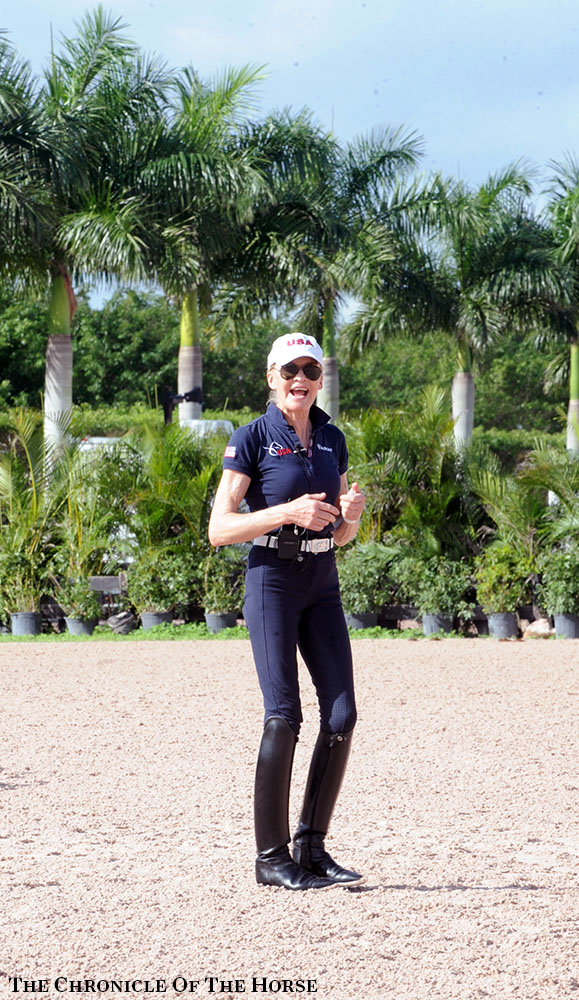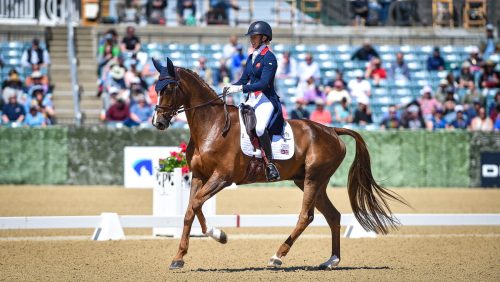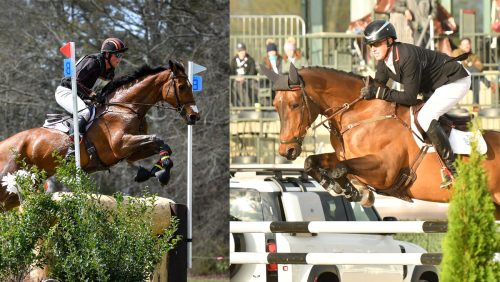Wellington, Fla. – Dec. 31
“Dressage is the basis.”
George Morris may not have been in attendance at his 10th annual horsemastership training session, but surely each of the 12 participating riders heard those thoughts run through their heads as they received instruction from U.S. Dressage Young Horse Coach Christine Traurig Thursday at the Palm Beach International Equestrian Center for the three-day clinic’s opening session.
Morris is taking a sabbatical from teaching, but his horsemastership training session continues on, this year with substitute educators Traurig, Beezie Madden and Laura Kraut, all Olympic medalists in their respective disciplines. Over the course of three days, the riders, who have received invitations to the event based on their riding accomplishments in 2015, will be schooled on flatwork by Traurig, gymnastics by Madden, and Nations Cup-style jumping by Kraut.
Throughout the process, they will also care for their own horses without the assistance of grooms or trainers, but they will have excellent resources at their disposal, as they will receive instruction on equine care and management from barn manager Colleen Reed and learn about veterinary care from Dr. Tim Ober, the U.S. Show Jumping Team veterinarian at numerous Nations Cup and Championship competitions.
The following riders, separated into two groups, are participating:
Group 1
Victoria Colvin (18 years old): Loxahatchee, Fla. – Platinum Performance/USEF Show Jumping Talent Search Finals – East champion, WIHS Equitation Finals champion
Kelli Cruciotti (18): Elizabeth, Co. – Wild card selection; Pessoa/USEF Hunter Seat Medal Finals champion
Lucy Deslauriers (16): New York, N.Y. – North American Young Rider Championships individual show jumping gold medalist, National Junior Jumper Championships individual gold medalist
Eve Jobs (17): Palo Alto, Calif. – Wild card selection; 3rd place, Platinum Performance/USEF Show Jumping Talent Search Finals – West
Katherine Strauss (17): New York, N.Y. – Wild card selection; 2015 USEF U25 National Championship reserve champion
Vivian Yowan (18): Lexington, Ky. – North American Junior Championships individual show jumping gold medalist
Group 2
Ailish Cunniffe (18): South Salem, N.Y. – Wild card selection; 6th place, ASPCA Maclay National Championship
Mitch Endicott (17): Rancho Santa Fe, Calif. – Wild card selection; 4th place, Platinum Performance/USEF Show Jumping Talent Search Finals – West
Daisy Farish (15): Lexington, Ky. – Wild card selection; 2015 Devon Junior Jumper Champion
TJ O’Mara (17): Rumson, N.J. – Wild card selection; 4th place, Platinum Performance/USEF Show Jumping Talent Search Finals, East
Ransome Rombauer (17): St. Helena, Calif. – 2015 Platinum Performance/USEF Show Jumping Talent Search Finals – West champion, USHJA Emerging Athletes Program reserve champion
ADVERTISEMENT
Danielle Roskens (20): South Lyon, Mich – USHJA EAP champion
Detail-Oriented
Traurig tested the riders’ ability to manage their horses, many of which were loaned to the riders just for the duration of the three days, from the get-go. When each group lined up for introductions, Traurig examined the horses’ equipment; the way the bit fit inside each horse’s mouth was a point of emphasis.
“If I were fitting this horse, I would have chosen one an inch wider,” Traurig pointed out to TJ O’Mara.
No such detail went unnoticed by Traurig, who explained that her session was about applying the “scale of training.” Her goal was for each rider to establish every aspect of the scale with their horse: rhythm, contact, suppleness, energy and collection with impulsion.
“Make it a gymnastics exercise,” she said. “Right now, you are training the athletic ability of the horse. About 80 percent of flat work is spent on gymnast-isizing, conditioning and strengthening, carrying and pushing power, and self-carriage.”
“Keep roundness. Keep suppleness. Keep rhythm. Keep energy,” she repeated. “Training is repetition.”
The riders began the session by walking on a long rein, a movement that is almost never asked for in an equitation flat phase but is a crucial element of dressage tests.
“Feel that your horse strides out and marches,” Traurig said. “Every day when you start, spend five to 10 minutes walking on a long rein. Already this is part of what you call the warm-up. Walking on a long rein is not doing nothing.”
 |
| Christine Traurig teaching. Photo by Catie Staszak |
Traurig explained that working a horse on the flat is about seeking contact, not demanding it. The riders did not immediately take up on the reins when trotting. Traurig, fittingly for the first session of the clinic, focused instead on establishing tempo.
“Establish tempo, maintain it and stabilize it,” she said. “You want regularity in the step, where one step is like the other and the contact to the mouth is accepted. If the horse feels like the contact is a disturbance, the rhythm will rarely be regular.”
She praised Lucy Deslauriers’ control of her hot horse, as the 8-year-old Hamlet arrived at the session full of energy, at one point scooting forward and letting out a brief series of bucks. She encouraged Katherine Strauss, who rode with a forward position, to put more weight on her seat bone without riding with a heavy seat. She called Tori’s Colvin’s flexion of Whisper Z, “super.”
As the riders continued, Traurig had them apply more contact to establish roundness and suppleness. But she made sure the added contact did not take away from their rhythm. She pushed Kelly Cruciotti and Katherine Strauss to ride into the bridle a little bit more.
“The mere existence of contact does not mean slow down,” she said. “It means accept it. Go there.
“I notice with hunters and jumpers, that when they sit the trot, they go 0.00 miles per hour in order to make it easier,” she continued, inciting laughter from the crowd on hand. “If that is what you have to do in order to sit the trot, your horse is not working through his back. Just because you want to be smooth, that does not mean you do not ride with consequence.”
All About Topline
“This flat session is all about topline – connecting the ends through the arc of the horse,” Traurig said. “The neck and back have to relate to each other.”
With both groups, Traurig emphasized this point ad nauseam. She had the riders work on achieving an exemplary balance of roundness, suppleness and rhythm through leg yields and haunches in exercises.
And it wasn’t just about legs and hands, or even calves and thigh muscles. She got down to the nitty-gritty of giving roles to specific fingers on the reins.
ADVERTISEMENT
“The ring finger is the thermometer of the horse’s mouth,” she said. “It should be sensitive to the bit.”
Traurig also referenced anatomy, discussing how the different muscles in the horses neck and back connect, relate to and affect one another, and she even dabbed in geography when discussing the role of the inside and outside reins.
“The longitudinal position of the neck is established and maintained by the outside rein,” she said. “The neck has to stay in the center of the shoulders. Then the inside rein influences the latitudinal flexibility of the neck.”

Ransome Rombauer on Liverpool. Photo by Catie Staszak
She applauded Ransome Rombauer for getting her mount supple but also cautioned her not to over-bend her horse, and she helped Danielle Roskens work through some stiffness in her horse’s neck. She pushed Mitch Endicott to improve his downward transitions.
In the first session, Traurig made Cruciotti repeat the trot to walk transition twice to improve her horse’s response to her contact and avoid invertedness – “You want the horse to transition into frame with his hind legs and to not get unsteady in the contact,” she said – but the second group was drilled much more extensively on that principle.
“Every transition asks for preparedness,” she said as the riders repeated the trot to walk transition again, and again, and again.
There was a method to her madness, and at the end of the session, Traurig related dressage and flatwork principles back to jumping.
“The more athletically developed a horse is, the prompter it can respond, because it knows how to handle its body,” she said. “The quickest horse in the turns in the jump-off is the one that responds to the transition-giving aids and is the one that is also quickest after the jump to be quick on its forehand to get itself in a new direction.
“This is about fundamentals,” she added. “We want our horses to be prompt to aids and quicker to respond.”
Traurig On…
Seat: “Contact has three points: leg, seat and hand. When I’m talking about seat, I’m never talking about a heavy seat. Your seat should never substitute the lack of functionality of your leg.”
“Your seat is the mediator between leg and hand. It can support either in relation to what the rider feels.”
Riding on a Bent Line: “The scale of training must be maintained when on a bent line. Flexion laterally in the poll and neck should be in relation to the amount of bend in the body so that the horse stays in alignment. An over-bent horse escapes through the outside rein, and the horse loses alignment.”
Roundness and Suppleness: “When you feel the wither come up to you a little bit more, that is roundness. You allow more weight in your rein to feel that contact is accepted, and then you follow the contact. The roundness in the topline depends on contact and your leg mobilizing the horse’s hind leg. Suppleness is the acceptance in the horse’s body to be aided in a certain way.”
Yielding: “When you are driving and bending, your leg is at the girth. When yielding, the position of the inside leg changes and move slightly behind the girth. The horse is not bent in the body when yielding.”
Follow along with all of the Chronicle’s reports from the George H. Morris Horsemastership Training Sessions.
The sessions continue Friday with a flatwork and gymnastics demonstration by Beezie Madden at 8:00 a.m. The mounted instruction with Madden begins at 9:30 a.m.














